Linux中的文件处理工具
1.grep [Globally search a Regular Expression and Print]
grep -E = egrep
grep 格式
grep 匹配条件 处理文件
grep root passwd ##过滤root关键字
grep -i root passwd ##后略大小写
grep -E "<root" passwd ##root字符之前不能有字符
grep -E "root>" passwd ##root字符之后不能有字符
grep -数字 ##显示过滤行以及上面几行和下面几行
grep -n ##显示匹配的行所在行号
grep -A ##显示过滤行以及下面几行
grep -B ##显示过滤行以及上面几行
grep -v ##反向过滤

grep -E “root|nologin” /etc/passwd ##含有root和nologin的行
grep -e root -e bash /etc/passwd ##含有root和bash的行
grep -i root /etc/passwd ##忽略大小写查找含root的行
grep -E “<root>” /etc/passwd ##root前后都不能有字符的行
grep -5 halt /etc/passwd ##显示含有关键字的前后各5行 
grep -B5 halt /etc/passwd ##含有关键字的前5行
grep -A5 halt /etc/passwd ##含有关键字的后5行
grep root /etc/passwd -v ##反选,不含有关键字的行
grep字符数量匹配规则
^westos ##以westos开有
westos$ ##以westos结尾
w....s ##w开头s结尾中间4个任意字符
.....s ##s结尾前面5个任意字符
* ##字符出现任意
? ##0到1次
+ ##1次到任意次
{n} ##n次
{m,n} ##m到n次
{0,n} ##0-n次
{,n} ##0-n次
{m,} ##最少m次
(lee){2} ##lee字符串出现2次

grep w.s text ##ws之间一个字符
grep w..s text ##ws之间两个字符 
grep w…s text ##ws之间三个字符
grep -E “w.{2}s” text ##ws之间两个字符
grep -E “w.*s” text ##ws之间任意个字符
grep -E “wa*s” text ##ws之间任意个a
grep -E “wa{1}s” text ##ws之间1个a
grep -E “wa?s” text ##ws之间任意个a
grep -E “wa+s” text ##ws之间1-任意个a 
grep -E “wa{1,}s” text ##ws之间1-任意个a
grep -E “wa{1,2}s” text ##ws之间1-2个a
grep -E “w(ab){2,}s” text ##ws之间2-任意个ab
练习脚本:
请显示系统中能被su命令切换的用户名称
grep -E "bash$|sh$" /etc/passwd | cut -d: -f 1

2.sed
命令格式:
sed 参数 命令 处理对象
sed 参数 处理对象 -f 处理规则文件
对字符的处理
p ##显示
sed -n 5p westos ##显示第五行
sed -n 3,5p westos ##显示3到5行
sed -ne '3p;5p' westos ##显示3和5行
sed -ne 1,5p westos ##1-5行
sed -ne '5,$p' westos ##5到最后以行
sed -n '/^#/p' /etc/fstab ##显示以#开头的行

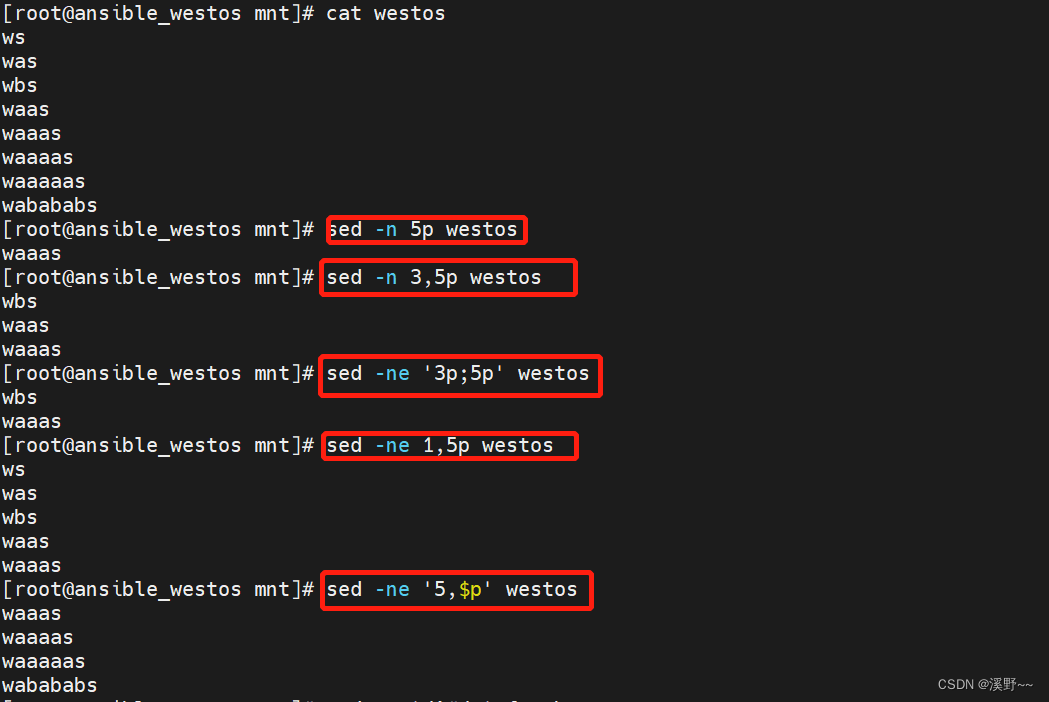

d ##删除
sed 5d westos ##删除第五行
sed '/^#/d' fstab ##把#开头的行删除
sed '/^UUID/!d' fstab ##除了UUID以外的行都删除
sed -e '5,$d' westos
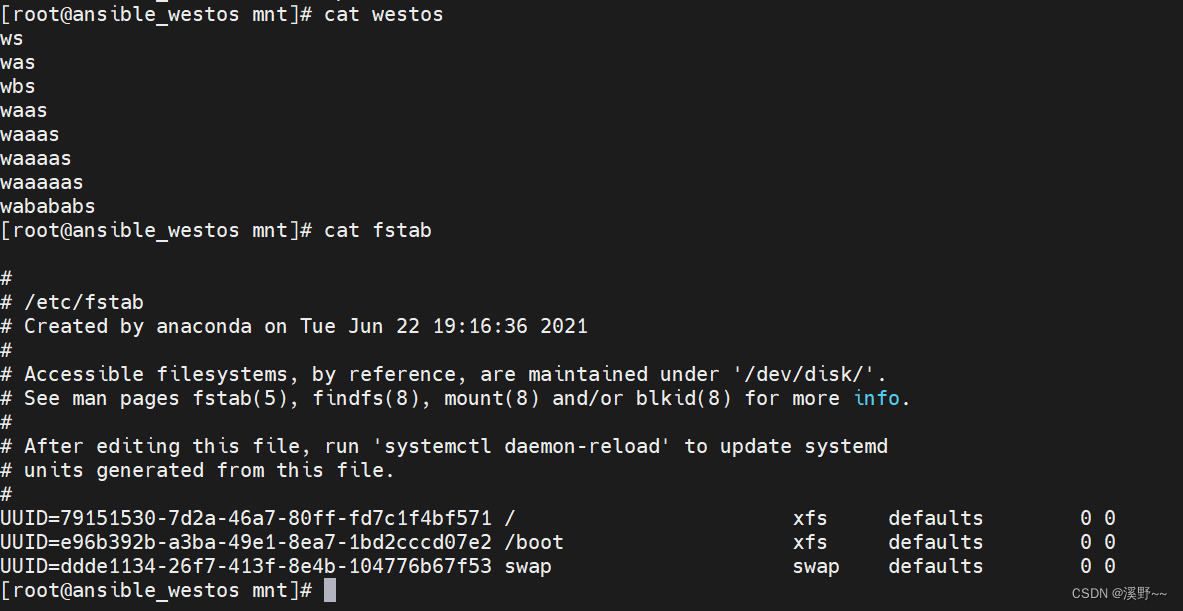



a ##添加
sed -e '$a hello world' fstab
sed -e '$a hellonworld' fstab
sed -e '/^#/a hello world' fstabc

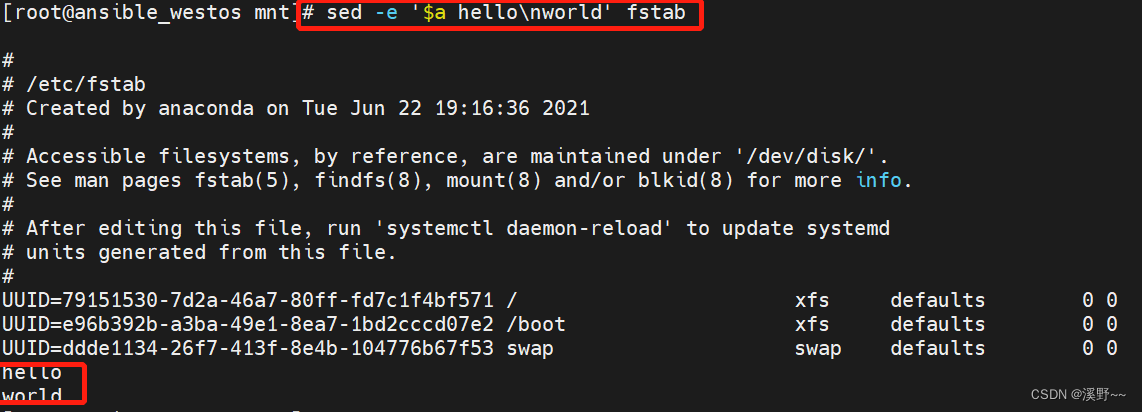
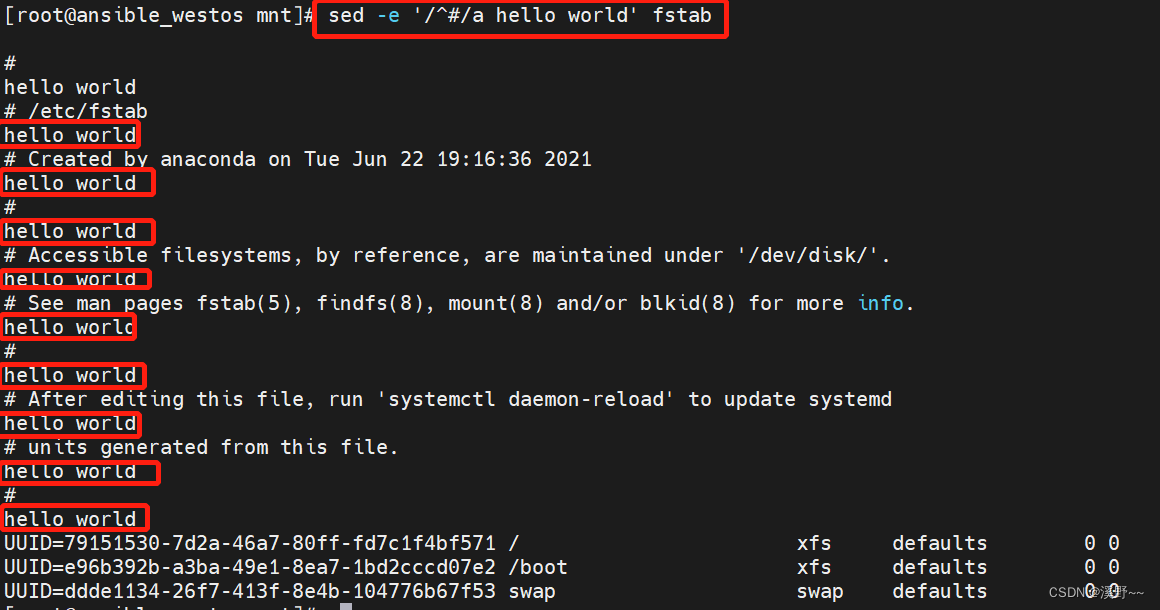
c ##替换
sed -e '/^#/c hello world' fstab
sed '5chello world' westos
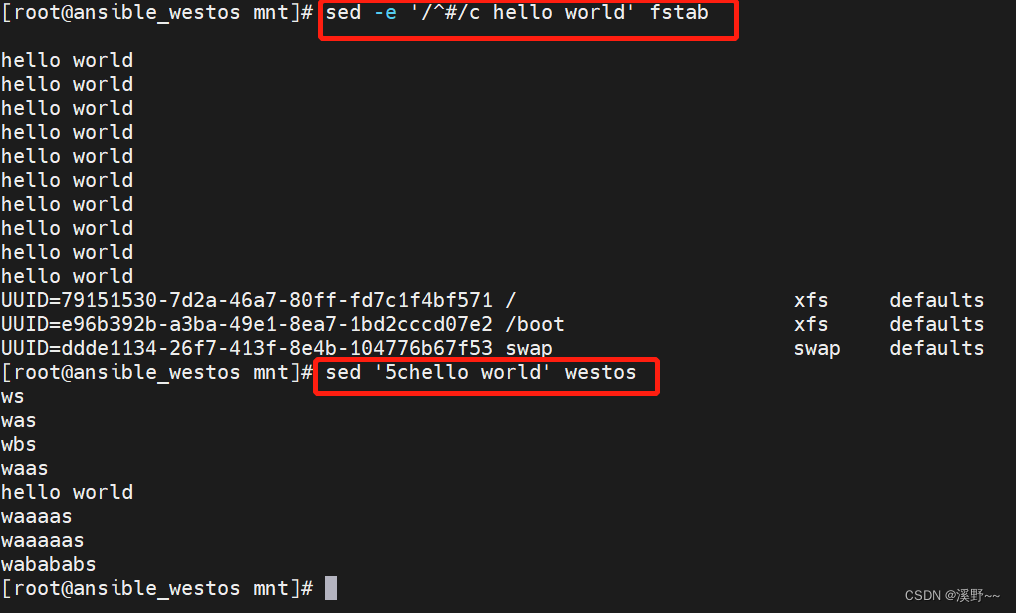
w ##把符合的行写到指定文件中
sed '/^UUID/w text' westos ##把westos中UUID开头的行写入text中
sed '/nologin$/w text' /etc/passwd ##将passwd中的以nologin结尾的写入text中
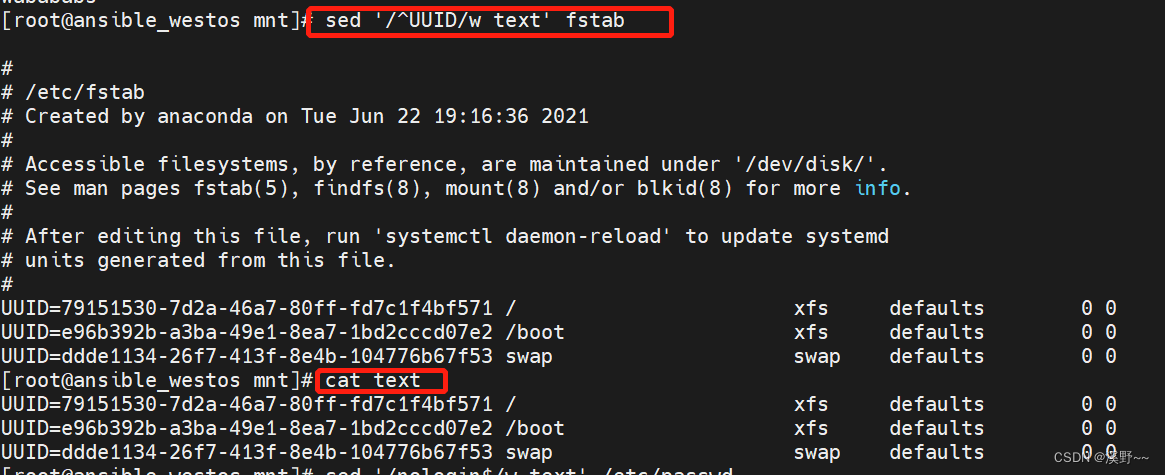


i ##插入
sed '5ihello westos' westos
sed '/westos/i westoslinux' westos 在westos中的westos前面插入westoslinux
sed '/westos/a westoslinux' westos 在westos中的westos后面插入westoslinux

r ##整合文件
sed '5r ansible' westos 将ansible中的内容整合到第5行的下面

sed 字符替换
sed 's/:/###/g' westos
sed 's/:/###/' westos
sed 's/:/###/g' westos
sed '1,5s/:/###/g' westos
sed '1s/:/###/g' westos
sed '1s/:/###/g;5s/:/###/g' westos
sed '/lp/,/shutdown/s/:/###/g' westos
sed 's///####/g' westos
sed 's@/@####@g' westos
sed 's@/@####@g' -i westos
把sed处理的内容保存到westos文件中
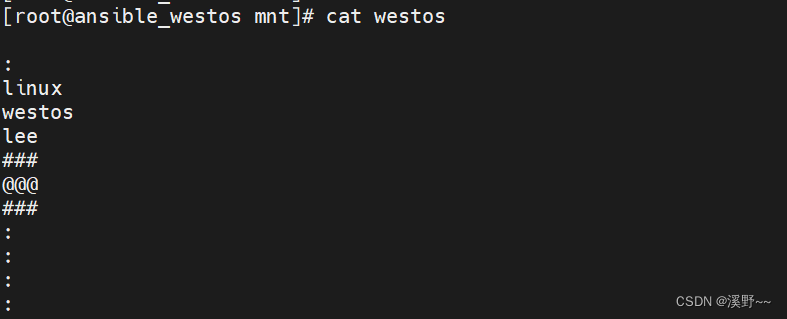
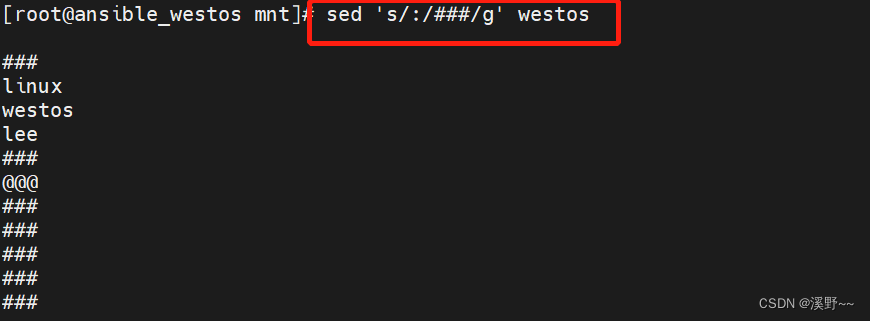
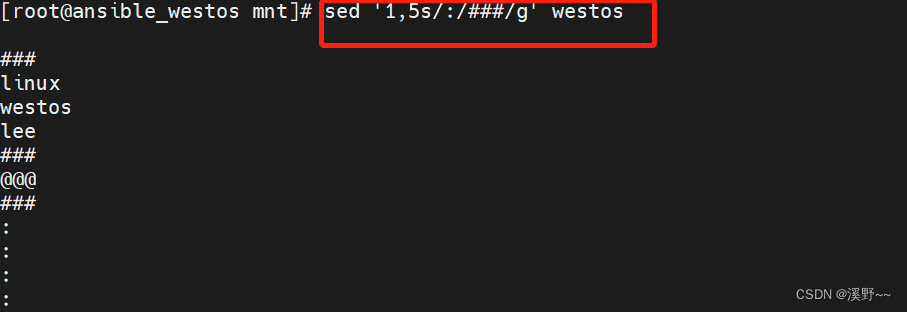
练习及脚本
Apache_port.sh
此脚本接入数字
http的端口就改为此数字
假设selinux为关闭状态
例如:
sh Apache_port.sh
ERROR: Pleaase input port number following script !!
sh Apache_port.sh 8080
apache的端口会被修改为8080
#!/bin/bash
setenforce 0 &> /dev/null
[ -z "$1" ] && {
echo "Error:PLease input port number!!!"
exit
}
rpm -q httpd &> /dev/null || {
echo "Error: Apache is not running!"
exit
}
systemctl status httpd | grep "running" &> /dev/null || {
echo "Error : Apache is not running!!"
exit
}
netstat -antlupe | grep -E ":$1>" &> /dev/null &&{
echo "Error:$1 is in used!"
exit
}
sed "/^Listen/c Listen $1" -i /etc/httpd/conf/httpd.conf
systemctl restart httpd


3.awk
awk -F 分隔符 BEGIN{}{}END{} FILENAME
NR ##行数
NF ##列数
FILENAME ##文件名称本身
westos ##westos变量值
“westos” ##westos字符串
/bash$/ ##条件
/条件1|条件2/ ##条件1或者条件2
/条件1/||/条件2/ ##条件1或者条件2
/条件1/&&/条件2/ ##条件1并且条件2
$0 ##所有的列
$1 ##第一列
$2 ##第二列
$3 ##第三列
awk -F : ‘$6!~/home/&&/bash$/{print}’ /etc/passwd ##/etc/passwd文件的第六列没有home关键字并且以bash结尾的行
awk -F: ‘{print NR}’ passwd ##打印行数
awk -F: ‘{print NF}’ passwd ##打印列数 awk -F: ‘{print FILENAME}’ passwd ##打印文件名
awk -F: ‘{print FILENAME}’ passwd ##打印文件名 awk -F: ‘/nologin$/{print $1,$7}’ /etc/passwd ##打印一nologin结尾的所有的行
awk -F: ‘/nologin$/{print $1,$7}’ /etc/passwd ##打印一nologin结尾的所有的行 awk -F: ‘/nologin$|^root/{print $1,$7}’ passwd ##两个条件或的关系
awk -F: ‘/nologin$|^root/{print $1,$7}’ passwd ##两个条件或的关系
awk -F: ‘/bash$/&&/^root/{print $1,$7}’ /etc/passwd ##两个条件且的关系 
awk -F: ‘$7~/bash$/{print $0}’ /etc/passwd ##第七列以bash结尾的打印 
awk -F: ‘$7!~/bash$/{print $0}’ /etc/passwd ##第七列不是bash结尾的打印 
课后练习:
统计在系统中能su切换的并且用户加目录不在/home下的用户数量
awk -F: 'BEGIN{N=0}$6!~//home/&&/bash$|sh$/{N++}END{print N}' /etc/passwd





